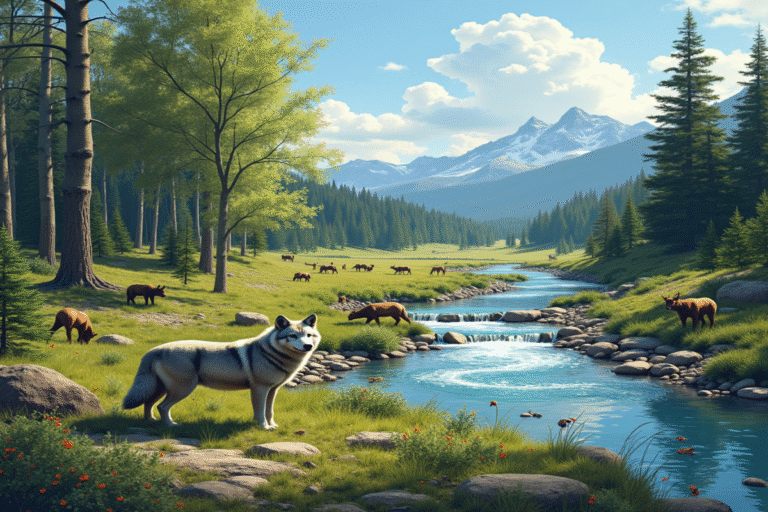Imagine a wild canine so influential that its presence can reshape entire waterways, bring back disappearing trees, and restore ecosystem balance. This isn’t fantasy—it’s the extraordinary ecological change observed when wolves returned to Yellowstone National Park after a 70-year absence.
The Ecological Void: A Park Without Predators
By the early 1900s, government-sponsored hunting had eliminated wolves from Yellowstone. Without these apex predators, elk populations exploded and moved freely across the landscape. These large herbivores grazed without restraint, especially on the tender shoots of riverside willows, aspens, and cottonwoods. Over decades, this unchecked feeding dramatically altered the park’s ecology.
In 1995, everything changed. Scientists reintroduced 31 gray wolves from Canada to Yellowstone, beginning one of the most significant ecological experiments in history.
Beyond Simple Predation: The Behavioral Revolution
What scientists discovered next surprised the ecological community. The wolves’ impact wasn’t just about reducing elk numbers—it changed how elk behaved. This is an example of a “trophic cascade”—where effects at the top of the food chain ripple downward, transforming multiple levels of the ecosystem.
The elk, once comfortable lounging beside rivers and grazing in open valleys, started avoiding these risky areas where wolves might hunt them. This subtle behavioral shift set off a dramatic chain reaction throughout the park.
From Predator to Landscape Architect
With less browsing pressure along riverbanks, young willows, aspens, and cottonwoods that had been eaten for decades started to thrive. In some areas, willow stands grew as much as five times taller. Aspen groves, which had struggled to regenerate, began producing new growth.
This revival in vegetation attracted beavers, nature’s engineers, who returned to areas they had previously abandoned. By 2006, the beaver population increased significantly, with new colonies appearing throughout the park’s waterways.
The Miraculous River Transformation
Here’s where the story becomes truly remarkable: beavers built more dams, fundamentally altering the park’s hydrology. Their dams created wetlands, slowed water, reduced erosion, and transformed stream channels. Rivers that once flowed straight began forming networks of pools and channels.
The revitalized riverside vegetation further stabilized banks, reducing erosion during high water. Channels narrowed, deepened, and supported more diverse habitats. In some areas, water tables rose, creating streams that flowed year-round in places that had previously run dry in summer.
The Symphony of Returning Life
The benefits rippled through the ecosystem:
- Birds: Songbird diversity and abundance increased in recovering riparian areas.
- Fish: Improved, deeper, and cooler waterways created better habitat for trout and other fish species.
- Small mammals: Enhanced vegetation offered more cover and food for mice, voles, and other small creatures.
- Bears: Increased berries along riversides supported bears, especially in late summer and fall.
- Scavengers: Ravens, eagles, and magpies benefitted from the remains of wolf kills.
Even animals not directly linked to wolves thrived as the ecosystem regained balance.
Nature’s Delicate Interconnections Revealed
The Yellowstone wolf story powerfully illustrates the complex connections within nature. One species can start a cascade of changes that affects the entire landscape. Predators don’t just control prey populations—they shape whole ecological communities.
Scientists continue to study these effects, finding new links years after the reintroduction. For example, wolves help control coyote numbers, which affects small mammal populations, influencing seed dispersal and plant growth. Each new discovery reveals another layer in this ecological web.
Beyond Yellowstone: Global Implications
This kind of cascade isn’t unique to Yellowstone. Around the world, sea otters keep kelp forests healthy, and sharks help maintain coral reefs. In each case, top predators play a crucial role in preserving biodiversity. The Yellowstone story has become a compelling argument for protecting keystone species—those with outsize influence on their ecosystems.
The most inspiring lesson is about resilience. When the necessary species return, damaged ecosystems can recover in ways we never imagined. Yellowstone’s wolves remind us that nature is a dynamic, interconnected web, where every member matters in keeping the system whole.
The next time you look at a river winding through a forest, remember that its shape may be influenced not just by rocks and rain, but by the hunting patterns of wolves and the alertness of prey—a beautiful testament to the intricate complexity of our natural world.





